How to apply Group Policy only to non-administrators in Windows 10
Group Policy makes it easier to configure some settings in Windows. When changing a specific policy (depending on the computer or user configuration), it will be applied to any computer and user.
However, if you want to apply some specific policies such as disk access restrictions, how to do for non-administrators? This article will show you how to apply group policy to non-system administrators.
- 10 important Windows Group Policy settings need to be done immediately
- How to reset Local Group Policy settings on Windows 10
- Install the printer using Group Policy Object
Note:
- Group policy is only available for Windows Pro and Enterprise users. If you are using Windows Home version, you cannot follow this guide.
See also: How to install Group Policy Editor (GPEdit.Msc) on Windows 10 Home Edition
- This tutorial works on Windows 10 but you can apply for Windows 7 and Windows 8.
How to apply group policy to non-administrators
Because the Group Policy Editor normally doesn't allow you to apply policies only to a specific user group, we need to create a group policy snap-in on the machine using MMC (Microsoft Management Console).
Step 1 . Press the Windows + R key, type mmc and click the OK button to open the Microsoft Management Console. You can also search mmc on the Start menu.

Step 2 . In the Microsoft Management Console window, go to File in the top navigation bar and select the Add / Remove Snap-in option .
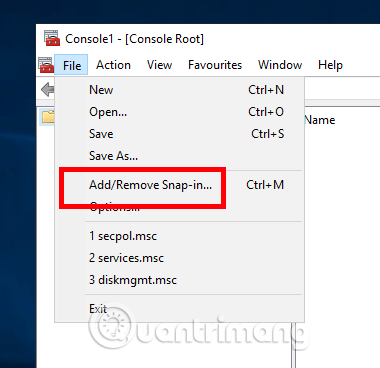
Step 3 . This will open the Add or Remove Snap-ins window. Here, you need to find the Group Policy Object Editor in the left pane, select it and click the Add button.

Step 4 . Now we need to select all non-admin accounts. In the Group Policy tutorial, click Browse .
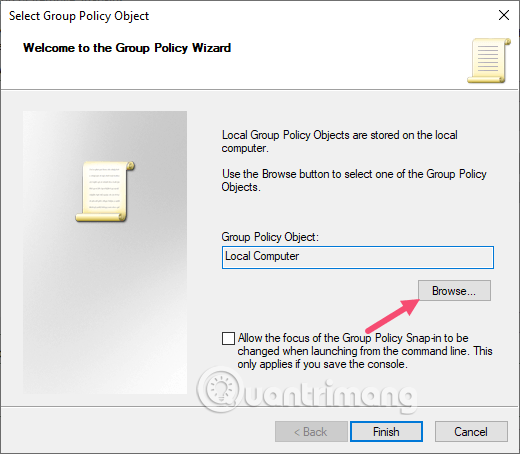
Step 5 . Access the Users tab, select Non-Administrators from the Local Users and Groups list and click the OK button.
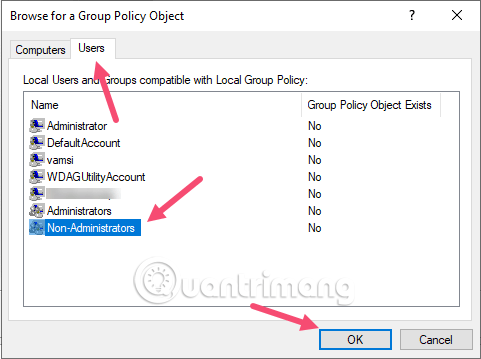
Step 6. On the screen, click the Finish button to save the changes.
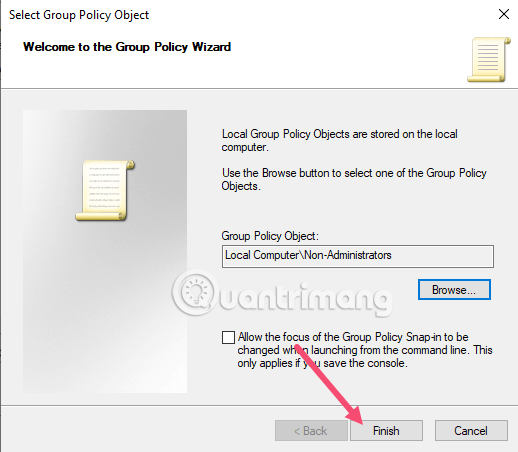
Step 7 . You have just completed adding a snap-in with custom settings. Now we need to save this snap-in for later use if desired. To save, go to File and select the Save As option.

Step 8 . Go to where you want to save the snap-in, name the snap-in, make sure in the Save as type field: select Microsoft Management Console Files (* .msc) and click the Save button. In this example, we will save the MSC file in the C drive root directory.
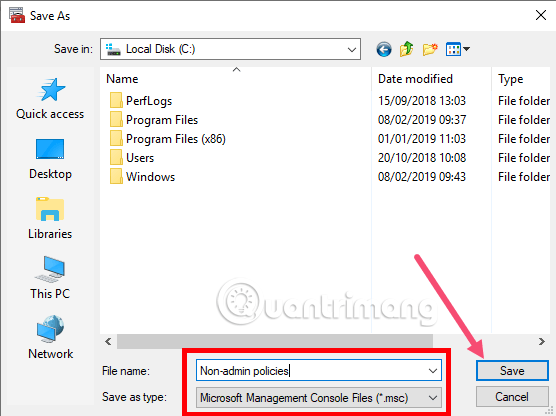
Step 9 . You can now use the snap-in you just created to apply group policy settings to all users except administrators by double-clicking on the file.
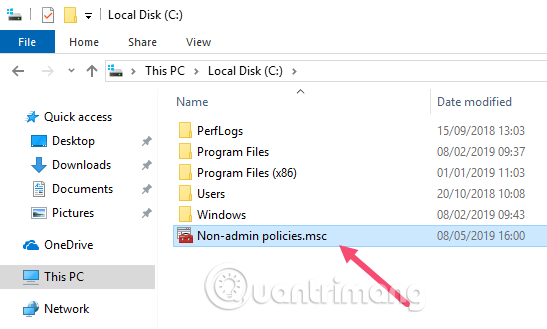
Step 10 . This will open the snap-in inside the MMC. Like the regular Group Policy Editor, find the policy and double-click it to change the policy settings. For example, if you do not want someone who is not an administrator to access a specific drive on your system, you need to change the option to Hide these specified drives on My Computer .
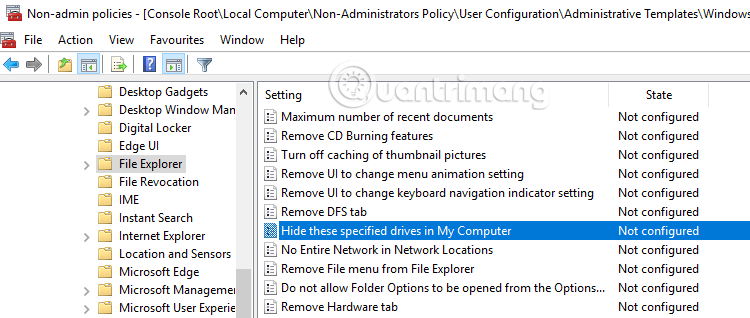
You can follow the same steps to apply policy settings to a specific user. Instead of selecting a group, simply select a specific user in Step 5.
I wish you all success!
You should read it
- How to reset Local Group Policy settings on Windows 10
- System Administration with Group Policy in Windows XP - Part I
- Use Group Policy Filtering to create a NAP DHCP enforcement policy - Part 1
- Configure App-V with Group Policy Objects
- 4 tips to open Local Group Policy Editor on Windows 8 / 8.1
- Install the printer using Group Policy Object
- Use Group Policy Filtering to create a DHCP enforcement policy for NAP - Part 2
- How to view all applied Group Policies in Group Policy Editor
May be interested
- How to install the Microsoft Edge Group Policy template on Windows 10
 on windows 10, you can download and install group policy templates to manage microsoft edge settings, and this guide will show you the process.
on windows 10, you can download and install group policy templates to manage microsoft edge settings, and this guide will show you the process. - Use Group Policy Filtering to create a DHCP enforcement policy for NAP - Part 2
 how to use the nap policy wizard to automatically create network, health, and connection policies to control your network.
how to use the nap policy wizard to automatically create network, health, and connection policies to control your network. - Cannot open Local Group Policy Editor, quick fix
 to change configuration and important windows policies, windows 11 users will use local group policy editor. in case you cannot open the local group policy editor, immediately refer to the information in tipsmake's article!
to change configuration and important windows policies, windows 11 users will use local group policy editor. in case you cannot open the local group policy editor, immediately refer to the information in tipsmake's article! - Control Wifi access using Group Policy
 users can create a group policy setting that blocks workstations connected to any wi-fi network outside the specified network.
users can create a group policy setting that blocks workstations connected to any wi-fi network outside the specified network. - How to Edit Group Policy in Windows XP
 discussed herein are ways through which a pc user can be able to utilize the group policy snap-in to develop or edit the lists of applications that load automatically when you log into a pc running on windows xp. this option is utilized...
discussed herein are ways through which a pc user can be able to utilize the group policy snap-in to develop or edit the lists of applications that load automatically when you log into a pc running on windows xp. this option is utilized... - Configure App-V with Group Policy Objects
 group policy objects are increasingly used in centralized management of settings, especially for software products installed on many systems.
group policy objects are increasingly used in centralized management of settings, especially for software products installed on many systems. - Secure Endpoint with Group Policy
 group policy is an important mechanism in the network security process. here are some very useful settings to block network access.
group policy is an important mechanism in the network security process. here are some very useful settings to block network access. - Secure the internal admin group on the desktop
 there are three typical tasks you need to perform to protect the local administrators group. windows server 2008 and windows vista sp1 (installed rsat) will bring you incredible new controls that make these configurations soothing!
there are three typical tasks you need to perform to protect the local administrators group. windows server 2008 and windows vista sp1 (installed rsat) will bring you incredible new controls that make these configurations soothing! - How to block Internet access using Group Policy (GPO)
 this article will show you how to block internet access for users or computers in the active directory group policy object. this feature has been tested on windows 7, windows 10 and it works great!
this article will show you how to block internet access for users or computers in the active directory group policy object. this feature has been tested on windows 7, windows 10 and it works great! - How to use Local Group Policy Editor to tweak your computer
 this article will show you how to use local group policy editor to make computer changes.
this article will show you how to use local group policy editor to make computer changes.










 How to use Trend Cleaner to clean up Windows 10
How to use Trend Cleaner to clean up Windows 10 12 great Screensaver screensaver for Windows 10 computer screens
12 great Screensaver screensaver for Windows 10 computer screens How to view Netflix 4K on a Windows computer
How to view Netflix 4K on a Windows computer 12 programs and Windows applications are not required you should uninstall
12 programs and Windows applications are not required you should uninstall How to open the camera on laptop Windows 7/8/10
How to open the camera on laptop Windows 7/8/10 How to fix 0xC000021A error on Windows
How to fix 0xC000021A error on Windows